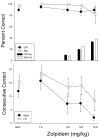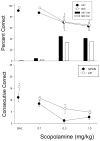Amnestic drugs in the odor span task: Effects of flunitrazepam, zolpidem and scopolamine
- PMID: 28893667
- PMCID: PMC5698133
- DOI: 10.1016/j.nlm.2017.09.006
Amnestic drugs in the odor span task: Effects of flunitrazepam, zolpidem and scopolamine
Abstract
The odor span task is an incrementing non-matching-to-sample procedure designed to provide an analysis of working memory capacity in rodents. The procedure takes place in an arena apparatus and rats are exposed to a series of odor stimuli in the form of scented lids with the selection of new stimuli reinforced. This procedure makes it possible to study drug effects as a function of the number of stimuli to remember. In the present study, the non-selective positive allosteric GABAA receptor modulator flunitrazepam impaired odor span performance at doses that did not affect a control odor discrimination. In contrast, the alpha-1 selective positive GABAA receptor modulator zolpidem and the cholinergic receptor antagonist scopolamine only impaired odor span at doses that produced more global impairment, including decreased accuracy in the control discrimination and increased response omissions in the both the odor span and control discrimination procedures. Even though the effects of flunitrazepam were selective to odor span performance, they did not depend on the number of stimuli to remember-the same degree of impairment occurred regardless of the memory load. These findings suggest that flunitrazepam interfered selectively with conditional discrimination performance rather than working memory and tentatively suggest that flunitrazepam's selective effects in the odor span task relative to the control odor discrimination are mediated by one or more non-alpha1 GABAA receptor subtypes.
Keywords: Flunitrazepam; GABA-A modulator; Odor span task; Scopolamine; Working memory; Zolpidem.
Copyright © 2017 Elsevier Inc. All rights reserved.
Figures





References
-
- Baddeley AD, Hitch G. Working memory. In: Bower GH, editor. Psychology of Learning and Motivation. Vol. 8. Amsterdam: Elsevier; 1974. pp. 47–69.
-
- Dudchenko PA. An overview of the tasks used to test working memory in rodents. Neuroscience and Biobehavioral Reviews. 2004;28:699–709. - PubMed
-
- Dudchenko PA, Talpos J, Young J, Baxter MG. Animal models of working memory: a review of tasks that might be used in screening drug treatments for the memory impairments found in schizophrenia. Neuroscience and Biobehavioral Reviews. 2013;37:2111–2124. - PubMed
MeSH terms
Substances
Grants and funding
LinkOut - more resources
Full Text Sources
Other Literature Sources
Medical

